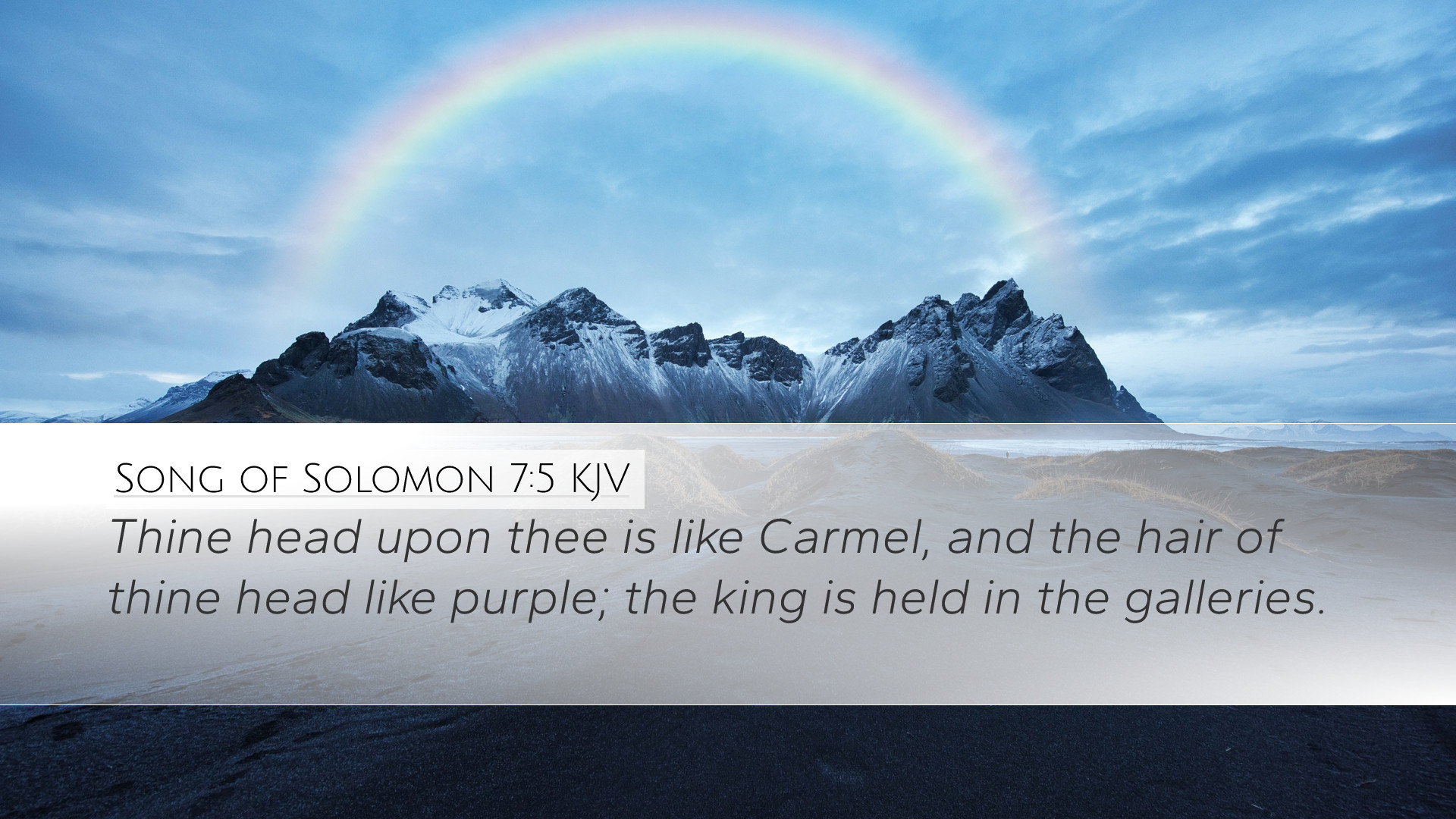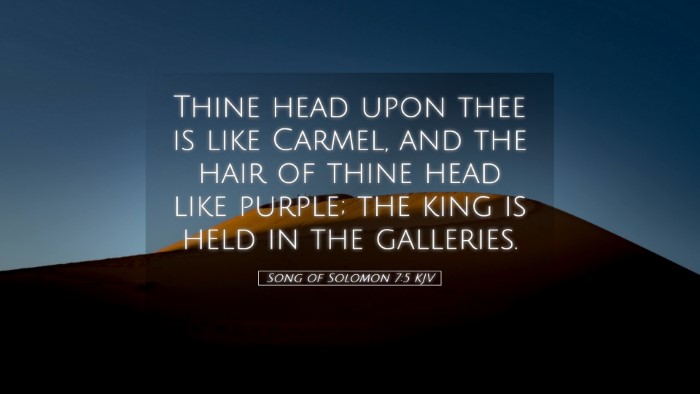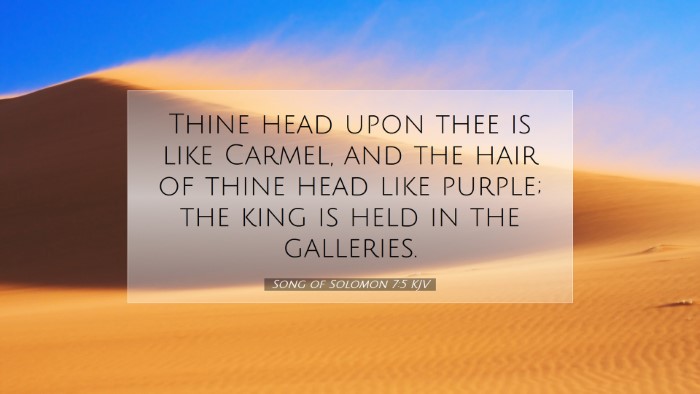Old Testament
Genesis Exodus Leviticus Numbers Deuteronomy Joshua Judges Ruth 1 Samuel 2 Samuel 1 Kings 2 Kings 1 Chronicles 2 Chronicles Ezra Nehemiah Esther Job Psalms Proverbs Ecclesiastes Song of Solomon Isaiah Jeremiah Lamentations Ezekiel Daniel Hosea Joel Amos Obadiah Jonah Micah Nahum Habakkuk Zephaniah Haggai Zechariah MalachiSong of Solomon 7:5
Song of Solomon 7:5 KJV
Thine head upon thee is like Carmel, and the hair of thine head like purple; the king is held in the galleries.
Song of Solomon 7:5 Bible Commentary
Commentary on Song of Solomon 7:5
Verse (Song of Solomon 7:5): "Thine head upon thee is like Carmel, and the hair of thy head like purple; the king is held in the galleries."
The Song of Solomon, often attributed to Solomon, is a poetic and allegorical text that explores themes of love, desire, and the beauty of human relationships. In this particular verse, the author expresses admiration for the beloved, drawing upon vivid imagery that captures both physical beauty and the deeper emotional and spiritual connections present in the act of love.
Observations from Commentators
Matthew Henry's Commentary
Matthew Henry elucidates this verse by emphasizing the significance of the imagery used. He observes that the reference to "Carmel" illustrates the height and beauty of the beloved's hair, likening it to the majestic mountain known for its lush greenery and beauty. Carmel signifies a place of delight, and in this context, it reflects the beloved's head, symbolizing a place of honor and a crown of beauty.
Henry comments on the phrase "the hair of thy head like purple," suggesting that the color purple represents royalty and richness. Here, it conveys not only the beauty of the beloved but also hints at the status and nobility attributed to her character. The hair is interpreted as flowing and luxurious, reinforcing the overall theme of enchantment and allure present in the beloved.
Henry further highlights that "the king is held in the galleries," indicating the power of love to captivate even the king. It reflects the allure of the beloved as a potent force that draws admiration and desire, suggesting that true beauty lies in character and virtue, which often holds even those of high status in reverent awe.
Albert Barnes' Notes
Albert Barnes provides a concise exposition of the symbols within this verse. He interprets "Thine head upon thee is like Carmel" as a metaphor for the physical stature and elegance of the beloved. According to Barnes, the imagery emphasizes the unparalleled beauty of the beloved while linking her appearance to a well-known and highly regarded geographical landmark.
On the depiction of hair, Barnes discusses the implications of "the hair of thy head like purple," remarking on the connotations of wealth and beauty associated with the color. He suggests that this reference to purple not only illustrates physical appearance but also elevates the beloved’s status in a society where such colors were associated with nobility and power.
Furthermore, Barnes reflects on the conclusion of the verse, where "the king is held in the galleries" signifies the place where admiration is drawn forth. The "galleries" symbolize spaces of observation, denoting both the external manifestation of beauty and the internal influences love can wield over the heart, reiterating the power of genuine affection and attraction.
Adam Clarke's Commentary
Adam Clarke elaborates on the influence of the metaphorical language within this verse. He interprets "Carmel" as a representation of the beloved’s delightful presence, reflecting the height and glory attributed to her. Clarke explains that the significance of the head represents authority and dignity, further arguing that it captures the essence of honor bestowed upon the beloved.
Clarke points out that "the hair of thy head like purple" can be understood in various ways, encompassing both the external beauty and the significance attributed to the beloved's character. The choice of purple, historically associated with royalty, elevates the beloved's qualities and attributes her with nobility.
Moreover, Clarke interprets the imagery of "the king held in the galleries" as a metaphor for the emotional responses invoked by love. The picture of the king being mesmerized suggests that even those who hold power can find themselves captivated by love’s profound and transformative beauty, bringing attention to the emotional depth and the humbling nature of genuine affection.
Thematic Reflections
From the combined insights of these commentaries, several prominent themes can be discerned:
- Beauty and Symbolism: The comparisons utilized in this verse, particularly with "Carmel" and "purple," underscore the importance of beauty as a multifaceted concept that encompasses both physical appearance and character.
- The Power of Love: The mention of the king illustrates the transformative power of love, suggesting that it can captivate individuals irrespective of their status or power.
- Divine Relationships: The poetic nature of the Song of Solomon has often led to interpretations that extend beyond romantic love to encompass the relationship between God and His people, pointing to the beauty in divine love and devotion.
Conclusion
In summary, Song of Solomon 7:5 offers a rich tapestry of imagery that conveys deep emotional and spiritual truths about love, beauty, and admiration. Through the insights of Henry, Barnes, and Clarke, we gain a greater understanding of how this Scripture reflects not only the physical attributes of the beloved but also the profound connections and emotional exchanges inherent in the experience of love. This poignant verse invites pastors, students, theologians, and scholars to explore the multifaceted nature of love, beauty, and their implications within both human relationships and the divine.


